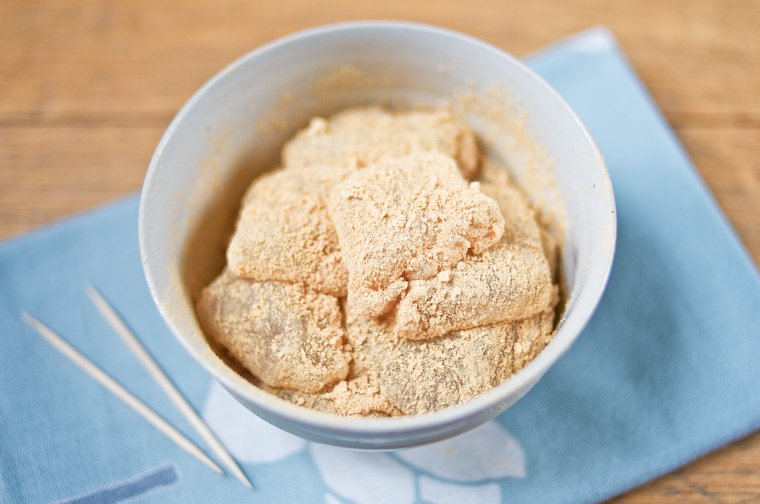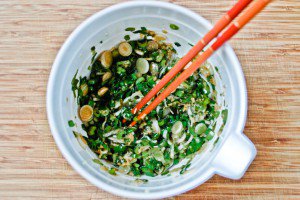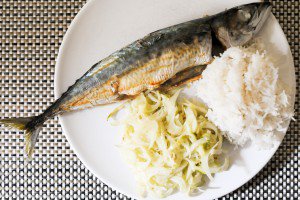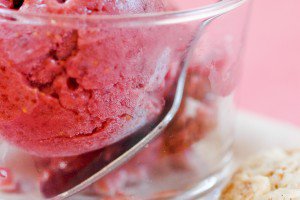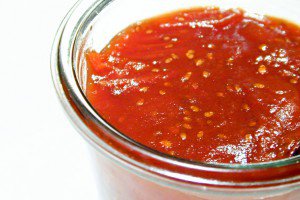We had our first taste of warabi mochi on the basement floor of the Tokyu department store in Shibuya, Tokyo. Amid the extraordinary spread of edible goods — sweet, savory and in between, fresh, dried, hot, cold — was a little stand from which a lady was offering samples of soft, bite-size morsels dusted with a light brown powder.
We each took a wooden pick, lifted a piece to our mouth, and started chewing. It was amazing: the coating was fine-grained and nutty — I recognized it as being kinako, toasted soybeans ground to a fine powder — and the fleshy inside was cool on the tongue, offering a slight chew then quickly dissolving into a delicate sweetness.
We were moved to purchase some right on the spot, but the lady took the time to explain that these had to be eaten fresh that very day, and we felt the box was too big for us to make that commitment.
Later, when our travels took us to the Kansai region, we started seeing that same mochi-like confection everywhere, shaped as small cubes, flat little bricks, or oval balls, slumped against each other. We bought some here, some there, and loved it every time, though we had no idea what it was, or what it was called.
Eventually, we got a small box at the Nishiki-dori market in Kyoto, and the top had a beautiful label on which I was able to decipher the hiragana characters like a six-year-old: wa-ra-bi-mo-chi. Aha!
I looked it up online that night, and found out that it is indeed a Kansai specialty, and a particularly popular treat during the summer months. Although it is called mochi, it is a different kind of mochi made not with glutinous rice flour (mochiko or shiratamako), but with warabiko, bracken starch painstakingly ground from the root of the plant.
In my bulging travel notebook, to the list of things to bring back from Japan I added: warabiko.
On another visit to the Nishiko-dori market, I spotted a stand that sold little bags of assorted flours and powders. We walked up to it and asked if they had any warabiko. They did, but the lady, aided by her daughter who in fact didn’t speak much more English than we did Japanese, managed to convey to us that pure warabiko was very pricey (~¥30,000 — $320 — for a 300-gram pouch). She could, however, offer a more economical substitute called warabimochiko, a blend of sweet potato starch and tapioca starch with a small percentage of bracken starch mixed in (~¥300 for the same amount). When I asked if my warabi mochi would still be oishii (delicious), they nodded forcefully.
Considering the price we’d paid for the different warabi mochi we’d tasted, it was clear they had not been made with the expensive stuff, so I got a bag of the low-cost warabimochiko, and the lady sweetly slipped us a little bag of kinako as a gift. A great many arigatos and small bows later, we walked away, hovering slightly above ground from the pleasure such small encounters provide.
About a week after we’d returned home, I took out the packets and got to work. To complement the little instruction sheet (in Japanese) the lady had included, I’d searched for recipes online and though there weren’t many in English or French, I’d found enough helpful ressources to feel prepared.
The process is really quite straightforward: you mix the starch with water and sugar, sieve the mixture into a saucepan, and cook until it thickens and becomes translucent. Then you simply dump it on a work surface dusted with kinako, cut it into pieces and coat them some more, or chill the mixture in ice water first for a more refreshing mouthfeel.
Within minutes my warabi mochi was ready, and all we had to do was wait for it to cool. Armed with toothpicks, we tasted one, then two, then a couple more, and smiled broadly: this was it! Part of me had not quite believed the warabi mochi experience could be reproduced in my Paris kitchen, but there was no doubt about it now: my batch had very precisely the same taste and texture as the ones we’d eaten on our trip. It was delicious.
Of course, the Japanese backdrop was sorely missing, but we chose not to dwell on that, and focus on the mochi instead. And now that I’ve found a Parisian source for warabimochiko (see ingredient note at bottom of recipe), I’ve promised myself I wouldn’t fall prey to the too good to use syndrome, and I’ll be making warabi mochi with abandon every time nostalgia strikes.

Have you tried this? Share your pics on Instagram!
Please tag your pictures with #cnzrecipes. I'll share my favorites!
Ingredients
- 60 grams (2 ounces) warabimochiko (see ingredient notes below recipe)
- 240 ml (1 cup) lukewarm water
- 50 grams (1/4 cup) sugar (I use a blond unrefined cane sugar)
- about 30 grams (1 ounce) kinako (toasted soybeans ground to a fine powder, available at Japanese markets)
Instructions
- Place the warabimochiko in a medium mixing bowl. Whisk in the water little by little until the mixture is smooth, with no lumps. Whisk in the sugar. The mixture will be thin.
- Sift the kinako and sprinkle it evenly to cover a silicone baking mat or a baking dish. (On the photo below, I hadn't sifted the kinako and later regretted it.)
- Set a fine-mesh sieve over a saucepan and pour the warabimochiko mixture through. Place the pan over medium heat. Stir with a wooden spoon constantly and energetically as the mixture heats and becomes thick and elastic.
- After just a little while, the mixture will turn translucent.
- When completely translucent, remove from the heat and pour the blob onto the prepared kinako, scraping the pan with a spatula; the dough will be very sticky. (Alternatively, you can pour the mixture -- whole or in small pieces -- into a bowl of ice water to chill first, before draining and coating with kinako.)
- Sprinkle the top with kinako, and use a dough cutter (or large knife) dusted with kinako to cut it into bite-size pieces.
- Separate the pieces and roll them around gently to coat on all sides. Let cool completely before eating.
- Transfer them to a serving dish with some of the remaining kinako (pour the rest back into the package) and serve with toothpicks. (In Japan, they were served with flat wooden picks with an angled point, that seemed to echo the shape of the kuromoji, the utensil used to cut pastries during the tea ceremony.)

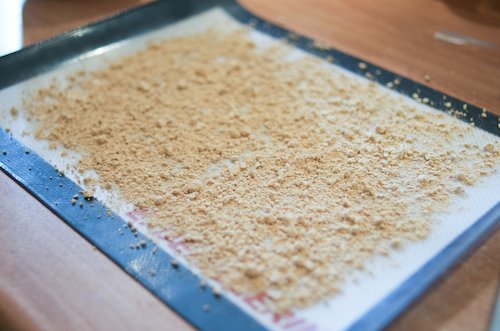

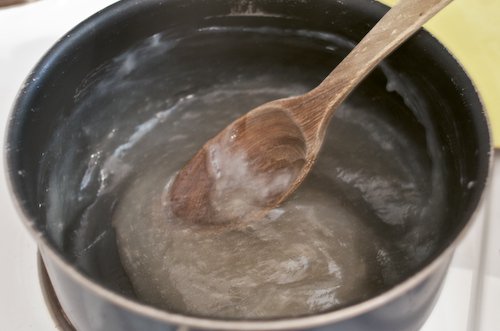
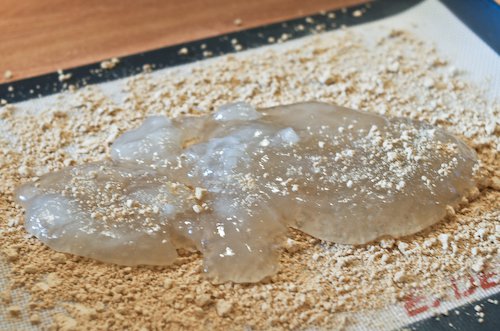
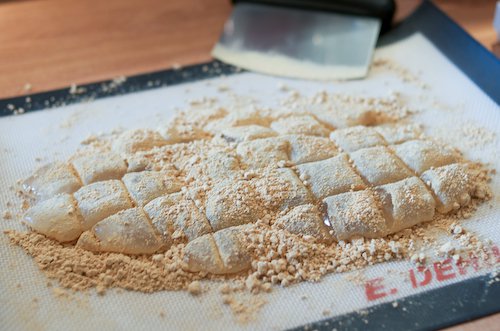
Notes
Warabi mochi will keep for a couple of days (despite what the lady said). Cover and keep at room temperature; if you refrigerate them, they'll get tough.
Ingredient notes:
Thanks to Hiroyuki, a member of the eGullet Japan forums I wrote to for guidance, I now know that there are three kinds of starches you can use to make warabi mochi:
– Hon warabiko (hon = authentic) is pure bracken starch. It comes in clay-colored little pebbles, it is very expensive, but it is the original flavor of warabi mochi (I’ve never tried it myself). The resulting paste is dark in color, and stickier than with the substitutes below.
– Warabiko contains a percentage of bracken starch, complemented with sweet potato starch and tapioca starch.
– Warabimochiko is the kind I got; it contains just a small amount of bracken starch — the rest is sweet potato and tapioca starch — and is much more affordable. It is white and comes in powdered or pebble form.
Outside of Japan, you may be able to find one of the above (and the kinako) at a Japanese market. If none are available, you can substitute katakuriko (potato starch), which is used to dust daifuku mochi and is less of a rarity, at least in Paris. Hiroyuki offers a recipe for his version of warabi mochi using katakuriko.
In Paris, the only place (to my knowledge) one can get warabimochiko is at Kanae, 118 rue Lecourbe in the 15th, 01 40 59 98 03 (map it!). It costs 2.30€ for 180 grams, which is about 30% more than I paid in Kyoto. I’ve combed through the Japanese grocery stores in the Rue Sainte-Anne neighborhood (Paris’ Little Tokyo) and couldn’t find any.
It is also customary to serve warabi mochi with a drizzle of kuromitsu (a dark unrefined can sugar syrup) in addition to kinako. In that case, you may want to reduce the amount of sugar a little bit.


